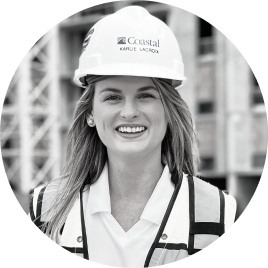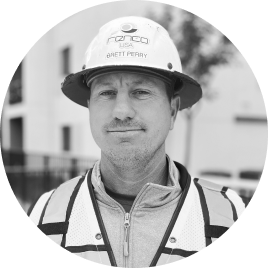08.15.2024 | Miami Herald
A cheaper, greener way to build in Florida?

Would you live in a greener place built from life-sized Legos?
Some people in South Florida already do — in a first-of-its-kind apartment project using innovative new building blocks designed to be assembled much like a giant toy kit. But unlike the structures your rambunctious 5-year-old can smash like the Hulk in seconds, the Miami company behind the blocks says they’re built to last and have been tested to withstand Category 5 hurricane winds.
RENCO, the company that developed the design and formula for the blocks, touts them as cleaner and greener than traditional construction methods. Rather than typical blocks of concrete, these are made from a mix of recycled glass and plastic, resins and limestone powder called calcite fused together under heat. Rather than blueprints, workers follow color-coded diagrams to fit the blocks together, then lock them in with glue.
“We can build projects now that are faster, cheaper, more economical, more sustainable, and more resilient than typical, conventional construction,” said RENCO President Kenneth Smuts. “I think that’ll give many opportunities for workforce housing, and for builders and developers to get more projects done to help solve a lot of social problems that a lot of our cities are having now.”
There’s also another big benefit that any Florida homeowner would appreciate. No wood means no termites.
The company has showcased its blocks in a new 96-unit, three-story apartment development called Lakewood in the small village of Palm Springs, just west of I-95 in Palm Beach County. They’re priced to appeal to working families with two-bedroom units going for $2,000 a month and three-bedrooms going for $2,500. The inside of the units look like any other nice new place but things are different behind the drywall and tiles.
Smuts said it took 11 workers just eight weeks to complete it. A project of that size using conventional materials would have taken at least three months to complete and likely more, he said. The speed of erecting a building shell is just one advantage for builders, he said. The savings could be passed on to buyers and renters.
“The only way you can save money is by time and labor on the job,” Smuts said.
RENCO says he blocks are also much easier to handle, an estimated 75 percent lighter than concrete blocks of similar size and the fittings on the top and bottom of the blocks, called studs in Lego world, anchor them together. Crews use glue guns to lock them in place permanently as the walls rise. Concrete blocks have to be tied together with lots of steel, plywood forms and poured concrete, which also takes a week to cure.
The company says assembling the blocks is easier, requiring fewer laborers and material. Following construction plans is a relatively simple process, with color-coded visuals showing what pieces to stack and where to put them —not unlike the directions in a Lego toy kit.
The company also says workers can be trained in a matter of hours to construct a building shell. Finishing a project, of course, still requires skilled trade work, like electricians, plumbers, tile installers and roofers. But overall, Smuts said, there would be less expense for labor, less need for heavy equipment like cranes, less cutting things to fit on site and less wasted material, which which means developers don’t have to pay for the big dumpsters.
“You’re not filling dumpsters up with tons of broken block or ends of cut wood framing or form work that you need for concrete,” said Smuts.
Cement Remains King
Building codes have changed dramatically in the past several decades in Florida, mostly with the aim of making homes and other structures more resistant to hurricanes and more energy efficient. So there are better nails in roofs, new hurricane-resistant windows and shutters, more steel or concrete in key areas and other changes. But many of the basics of construction have not changed that much — wood, steel and particularly cement are the go-to materials.
That carries costs to the climate. The cement industry is literally the foundation of most modern construction, used in everything from high-rises along the Florida coast to dams out West. But it’s also responsible for 8 percent of global carbon emissions, according to the U.S. Department of Energy.
Smuts, who in the past helped build highrise condos like ICON Brickell with the Related Group, doesn’t see the blocks as a total replacement for concrete. Lakewood and other structures that might be made with the blocks still need foundations to anchor to.
But RENCO hopes cost-savings alone could help its blocks break through in the Florida’s booming construction market. The company estimated that constructing a building with concrete blocks usually goes for $40 per square foot. They say their blocks, which use recycled glass and plastic, would run about $30 per square foot.
Company Ramping Up
The idea for RENCO, which means renewable composite, came from a Turkish businessman and company co-founder named Engin Yesil. He was inspired by construction techniques in his home country, where single-family homes, warehouses, and mosques are sometimes locked together like Legos.
The company — which is affiliated with Coastal Construction, a large Florida contracting firm that has done built billions of dollars worth of projects around South Florida — designed stronger materials and patented its process for the United States.
The company says the building system, blocks, joists, decking and adhesives have all been evaluated by the American National Standards Institute, certified laboratories that confirm the integrity of the product meets international standards. It has been tested in more than 24 states, the company says, with the material undergoing 400 safety tests, including for fire, extreme heat, cold and insects. Tests revealed the material didn’t rust or rot and termites didn’t want to eat it.
Smuts said getting approval on using a new material to build with was not for the “faint of heart” but eight years and $20 million later, the product is getting industry attention and winning awards.
Initially, one complication and cost factor was shipping blocks from Turkey, Smuts said. But in September, RENCO plans to open a new manufacturing facility in Jupiter, which should allow for wider use if builders begin to buy into the method.
The way it works is that developers and architects can send designs and RENCO can help create ideal block configuration kits. The blocks will be turned out in a massive 50,000-pound machines and a big carbon steel mold that melts and fuses the material.
Right now, building designs are limited to five stories for permitting purposes, Smuts said. But the company expects to get approvals later this year for up designs up to eight stories, which he said covers the majority of buildings that provide housing for American families.








